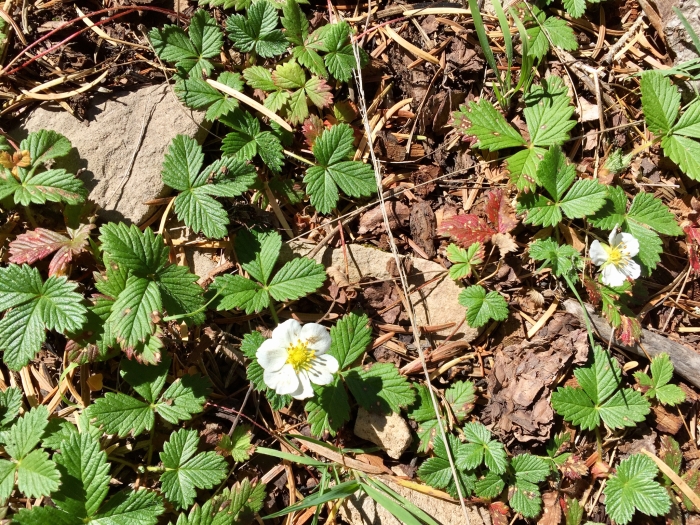Woodland Strawberry
(Fragaria bracteata)
Woodland Strawberry (Fragaria bracteata)
/
/

CK Kelly
CC BY 4.0
Image By:
CK Kelly
Recorded By:
Copyright:
CC BY 4.0
Copyright Notice:
Photo by: CK Kelly | License Type: CC BY 4.0 | License URL: http://creativecommons.org/licenses/by/4.0/ | Rights Holder: CK Kelly | Publisher: iNaturalist | Date Created: 2016-10-11T19:49:01Z |














Estimated Native Range
Summary
Fragaria bracteata, commonly known as Woodland Strawberry, is a deciduous perennial herb that thrives in the understory of open woodlands, forest edges, and along streams in the Western United States, as well as Central and Southwest Mexico. It typically grows to a height of 0.5 feet (0.2 meters) and can spread to about 1 foot (0.3 meters), forming a low-growing ground cover. The plant features trifoliate leaves and produces small, white flowers from late spring to early summer, which are followed by edible red strawberries that are attractive to wildlife and humans alike.
The Woodland Strawberry is valued for its edible fruit, ornamental value, and ease of maintenance. It is often used in garden borders, as a ground cover, or in edible landscaping. This strawberry prefers moist, well-drained soil and can tolerate a range of soil types, from sandy to loamy. While it does best in full sun, it can also tolerate partial shade, making it versatile for various garden settings. It requires moderate watering and can be propagated by runners. Gardeners should be aware that while generally disease-resistant, it can suffer from common strawberry pests and diseases, such as slugs and powdery mildew.CC BY-SA 4.0
The Woodland Strawberry is valued for its edible fruit, ornamental value, and ease of maintenance. It is often used in garden borders, as a ground cover, or in edible landscaping. This strawberry prefers moist, well-drained soil and can tolerate a range of soil types, from sandy to loamy. While it does best in full sun, it can also tolerate partial shade, making it versatile for various garden settings. It requires moderate watering and can be propagated by runners. Gardeners should be aware that while generally disease-resistant, it can suffer from common strawberry pests and diseases, such as slugs and powdery mildew.CC BY-SA 4.0
Plant Description
- Plant Type: Herb
- Height: 0.8-1 feet
- Width: 0.8-1 feet
- Growth Rate: Moderate
- Flower Color: White
- Flowering Season: Spring, Summer
- Leaf Retention: Deciduous
Growth Requirements
- Sun: Full Sun, Part Shade
- Water: Medium
- Drainage: Slow, Medium, Fast
Common Uses
Bank Stabilization, Bee Garden, Bird Garden, Butterfly Garden, Edible*Disclaimer: Easyscape's listed plant edibility is for informational use. Always verify the safety and proper identification of any plant before consumption., Low Maintenance
Natural Habitat
Open woodlands, forest edges, and riparian areas
Other Names
Common Names: Western Wood Strawberry, Western Woodland Strawberry, Fraisier À Bractée
Scientific Names: , Fragaria bracteata, Fragaria vesca subsp. bracteata, Fragaria vesca var. bracteata, Fragaria mexicana, Fragaria crinita, Fragaria vesca var. crinita, Fragaria vesca f. helleri, Fragaria helleri, Fragaria vesca f. bracteata
GBIF Accepted Name: Fragaria vesca subsp. bracteata (A.Heller) Staudt